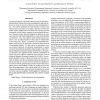Free Online Productivity Tools
i2Speak
i2Symbol
i2OCR
iTex2Img
iWeb2Print
iWeb2Shot
i2Type
iPdf2Split
iPdf2Merge
i2Bopomofo
i2Arabic
i2Style
i2Image
i2PDF
iLatex2Rtf
Sci2ools
ICPR
2008
IEEE
2008
IEEE
Image analysis approach for identification of renal transplant rejection
Acute renal rejection is the most common reason for graft (transplanted kidney) failure after kidney transplantation, and early detection is crucial to survival of function in the transplanted kidney. The current techniques for early detection of acute renal rejection are not accurate. For example, clearances of inulin and DTPA require multiple blood and urine tests, and they provide information on both kidneys together, but not unilateral information. Moreover, biopsy (the gold standard for diagnosis of acute renal rejection after renal transplantation) could cause bleeding and infection. Also, the relatively small needle biopsies may lead to over- or underestimation of the extent of inflammation in the entire graft. Hence, a noninvasive and repeatable technique would not only be useful but is needed to ensure survival of transplanted kidneys. For this reason, we introduced a new non-invasive framework for automatic classification of normal and acute renal rejection transplants usi...
Acute Renal Rejection | Computer Vision | ICPR 2008 | Rejection Transplants | Transplanted Kidneys |
| Added | 30 May 2010 |
| Updated | 30 May 2010 |
| Type | Conference |
| Year | 2008 |
| Where | ICPR |
| Authors | Ayman El-Baz, Georgy L. Gimel'farb, Mohamed Abou El-Ghar |
Comments (0)

